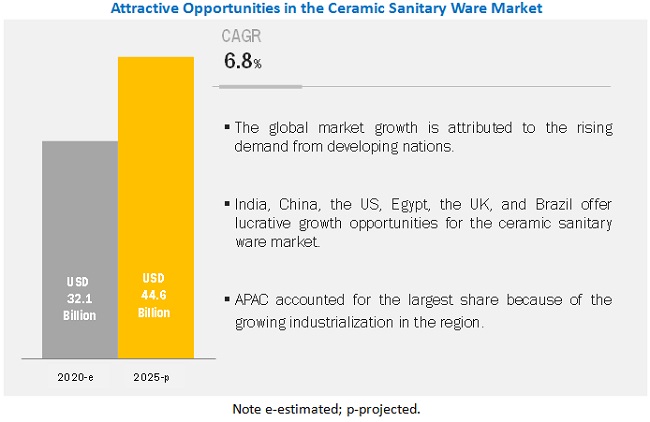
The global ceramic sanitary ware market size is projected to reach USD 44.6 billion by 2025, at a CAGR of 6.8%, from USD 32.1 billion in 2020. Initiatives by the public sectors of developing nations to improve access to sanitation are a major factor for the growth of the ceramic sanitary ware globally. Historically, the awareness regarding personal hygiene was low in developing nations. Therefore, the ceramic sanitary ware market had limited growth and development. However, due to the multiple initiatives taken by the governments of developing countries, the awareness about hygiene and proper sanitation is increasing. According to the latest data by the WHO, 45% of the global population used the safely managed sanitation service in 2017. This number is expected to increase in the coming years due to the rising public awareness, professional marketing of sanitation to those lacking the access, and initiative of the private sector in public sanitation. Moreover, the changing lifestyle and increasing purchasing power of the middle-class population are expected to drive the demand for the ceramic sanitary ware market between 2020 and 2025.
Download PDF Brochure: https://www.marketsandmarkets.com/pdfdownloadNew.asp?id=581
Toilet sinks/Water closets is the largest type of ceramic sanitary ware.
The toilet sinks/water closetssegment accounted for the largest share of the overall market, in terms of value, in 2019. It is also expected to be the fastest-growing segment during the forecast period. The demand from emerging nations and increasing consumer preference for toilet sinks to meet their basic sanitation requirements are driving the demand for toilet sinks/water closets. They have been further classified into one piece, two piece, wall hung closets, EWC, and others. APAC was the largest market for toilet sinks and water closets. The increasing disposable income of consumers, coupled with the growing demand for luxurious products, is driving the market for ceramic sanitary ware.
Commercial is projected to be the larger application of the ceramic sanitary ware market during the forecast period.
The commercial application accounted for the larger share of the overall market in 2019. Ceramic sanitary wares have a wide range of applications in the commercial sector. Owing to the heavy use and frequent replacement of ceramic sanitary ware in the commercial sector, the growth of ceramic sanitary ware is high in this application. Moreover, with the increasing urbanization, high growth is expected in the commercial application in developing regions during the forecast period.
APAC is the largest market of ceramic sanitary ware, followed by Europe and North America. The massive industrial growth in APAC has been fueling the growth of the ceramic sanitary ware market over the past few years, which is expected to continue during the next five years. Domestic and foreign investments in key sectors, such as energy, manufacturing, construction, and mining, have been consistently growing over the past decade. It is expected to result in the growth of the industrial sector and the demand for ceramic sanitary ware in the country.
Over the past decade, India has been witnessing a moderate GDP growth. The country has attracted heavy investments in key industrial sectors, such as construction, cement, and energy. The economic outlook for India has been very optimistic. The Government of India is focused on the manufacturing sector by liberalizing policies and providing additional incentives, such as land at cheap rates and faster clearances from all the concerned departments. As a result, the overall economy is rapidly growing. This is expected to drive the sale of ceramic sanitary ware in the region during the forecast period.
The key market players profiled in the report include Geberit Group (Switzerland), Kohler Co. (US), TOTO Ltd. (Japan), LIXIL Group Corporation (Japan), Roca Sanitario SA (Spain), Villeroy & Boch AG (Germany), RAK Ceramics (UAE), Duravit AG (Germany), Duratex SA (Brazil), and HSIL (India).